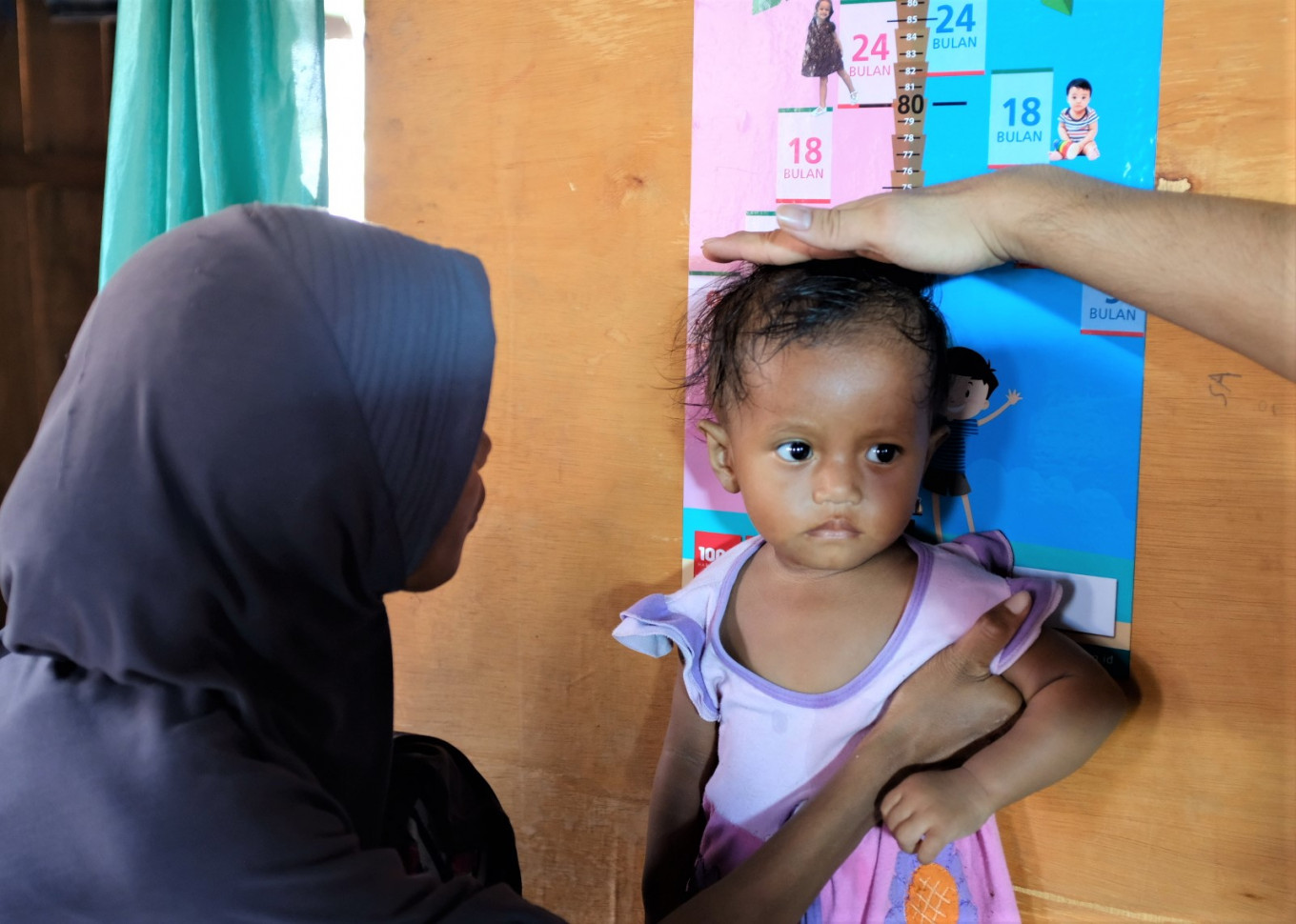Popular Reads
Top Results
Can't find what you're looking for?
View all search resultsPopular Reads
Top Results
Can't find what you're looking for?
View all search resultsStunting prevention in Indonesia: Strategy, will and collective effort
The consequences of stunting are immediate and lifelong. In addition to experiencing reduced cognitive function and delayed motor development, stunted children develop additional health problems in adulthood and stunted women have smaller babies, oftentimes perpetuating the vicious cycle of poverty.
Change text size
Gift Premium Articles
to Anyone
T
he real problem with stunting is not its impact on physical stature, but its effect on brainpower. Stunting, as defined by the World Health Organization (WHO), is the impaired growth and development children experience from poor nutrition, repeated infection and inadequate psychosocial stimulation.
Multiple studies have found that malnutrition in the first 1,000 days of life, from conception to 2 years of age, impairs brain development in ways that are irreversible. The brains of stunted children do not develop properly and the cognitive impairment is visible in brain scans. It is no surprise that stunted children suffer from learning disabilities and are more likely to drop out of school.
The consequences of stunting are immediate and lifelong. In addition to experiencing reduced cognitive function and delayed motor development, stunted children develop additional health problems in adulthood and stunted women have smaller babies, oftentimes perpetuating the vicious cycle of poverty.
There is ample evidence that early intervention works. Every US$1 spent on reducing stunting in Indonesia generates $48 in economic returns. The right programs and guidance can make it possible for individuals to realize their potential.
Indonesia is among the five countries in the world with the highest number of stunting cases. While the country reduced its prevalence of stunting was from 37.2 percent in 2013 to 27.7 percent in 2019, more than one in four children are stunted and unable to realize their full potential.
The quality of Indonesia’s human capital outcomes varies geographically and socially. For example, the under-5 child mortality rate in non-electrified rural areas is double the rate in urban areas.
A look at the service delivery data in Indonesia shows that each separate program (such as supplementation of folic acid and micronutrients during pregnancy or access to safe water and sanitation) has reasonable coverage. The reason stunting has remained high is because millions of 1,000-day households are missing out on the complete package of services required to move the needle.
In 2017, the government launched the National Strategy to Accelerate Stunting Prevention (StraNas Stunting), promising to invest $14.6 billion over four years to converge priority services across 514 regions. The StraNas Stunting scheme adopts a “whole-of-government” approach involving 22 ministries that cover health, early childhood education and development (ECED), water, sanitation and hygiene (WASH), food security and social protection incentives, and aligns different levels of government. Delivering the program at scale in highly decentralized Indonesia means reaching 24 million 1,000-day households in 75,000 villages. This requires careful planning and budgeting at the district and village levels.
A vital part of the government’s stunting reduction program is the introduction of Human Development Workers (HDWs). With over 72,000 HDWs across 416 regencies, these community-based workers have three functions: supporting villages to identify all 1,000-day households, assessing the villages’ current access to and use of priority services under the StraNas Stunting scheme, and monitoring and reporting the use of priority services through village convergence scorecards. These scorecards are then linked to direct fiscal transfers to village administrations.
StraNas Stunting is a significant step toward ensuring that all households with expectant mothers or children under 2 years have access to the complete package of services essential to reducing stunting. However, the government cannot do all this on its own. I highlight three opportunities for and examples of collaboration.
First is behavioral change communication. To prevent stunting, mothers should be encouraged to breastfeed exclusively until their babies are 6 months old. However, only one in two infants (0-6 months) in Indonesia is exclusively breastfed. Changing parental behavior requires not just better access to services on the supply side, but also increased awareness and knowledge on the demand side.
This change in behavior can be achieved only through a multi-sectoral behavioral change communication strategy that covers advocacy, interpersonal communication, community mobilization, the mass media and strategic use of data.
Second is social entrepreneurship. Individuals can be powerful engines for mobilization. A prime example of this is the Du Anyam social enterprise. Working closely with the talented women of Flores, Du Anyam produces wicker products that are sold nationwide. The profit it generates from sales is then used to educate women on the importance of nutrition, as well as to provide supplemental nutritious foods for the weavers and their children.
Third is public-private partnership. A national program with the scale and ambition of StrasNas Stunting stands to benefit from implementation support and an evidence-based approach to course correction. To catalyze this, like-minded philanthropic actors like the Tanoto Foundation and the Bill & Melinda Gates Foundation worked with the World Bank to launch the Multi-Donor Trust Fund for Indonesia Human Capital Acceleration. The trust fund invests in innovation and shares learning for scaling up through the national program, supports policy-relevant analytical work and provides capacity-building and technical assistance to the government.
Working with the Villages, Disadvantaged Regions and Transmigration Ministry, the trust fund is supercharging the HDW program by designing and testing new mobile app technologies to help HDWs track tasks, record monitoring data and generate reports easily. The Multi-Donor Trust Fund is also collaborating with the Vice Presidential Office and the National Development Planning Agency (Bappenas) to evaluate the impact of StaNas Stunting using mixed methods. This includes measuring stunting annually, accelerating learning and identifying best practices across the country, and investing in “nudge” experiments to change behavior, such as encouraging early initiation of breastfeeding.
Stunting is a multidimensional issue, but if Afghanistan and Bangladesh can make great progress, so can Indonesia. We have made promising progress over the last few years. But we can and we must do more, building on every milestone to achieve our national goal. In 2019, President Joko Widodo reaffirmed his administration’s commitment to tackling stunting and improving Indonesia’s human capital.
Indonesia’s human capital development journey is a collective one. Eradicating stunting demands collaboration and long-term thinking. We are better positioned to achieve impact at scale if we work together. Indonesia has the political will and a national strategy; what is left is for us all to roll up our sleeves and do our part.
***
The writer is member of board of trustees, Tanoto Foundation, where she plays an active role in shaping the foundation’s strategies and programs in poverty alleviation and human capital development.










